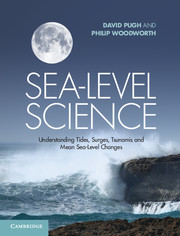Book contents
- Frontmatter
- Contents
- Preface
- List of acronyms
- List of main symbols
- Chapter 1 Introduction
- Chapter 2 Sea-level measuring systems
- Chapter 3 Tidal forces
- Chapter 4 Tidal analysis and prediction
- Chapter 5 Tidal dynamics
- Chapter 6 Shallow-water and coastal tides
- Chapter 7 Storm surges, meteotsunamis and other meteorological effects on sea level
- Chapter 8 Tsunamis
- Chapter 9 Spatial variations in sea level
- Chapter 10 Mean sea-level changes in time
- Chapter 11 Sea-level changes in time to do with the solid Earth
- Chapter 12 Sea-level applications
- Chapter 13 Sea level and life
- Appendix A Basic hydrostatic and hydrodynamic equations
- Appendix B Currents
- Appendix C High and low water times and heights from harmonic constituents
- Appendix D Theoretical tidal dynamics
- Appendix E Legal definitions in the coastal zone
- Glossary
- Index
- References
Chapter 5 - Tidal dynamics
Published online by Cambridge University Press: 05 May 2014
- Frontmatter
- Contents
- Preface
- List of acronyms
- List of main symbols
- Chapter 1 Introduction
- Chapter 2 Sea-level measuring systems
- Chapter 3 Tidal forces
- Chapter 4 Tidal analysis and prediction
- Chapter 5 Tidal dynamics
- Chapter 6 Shallow-water and coastal tides
- Chapter 7 Storm surges, meteotsunamis and other meteorological effects on sea level
- Chapter 8 Tsunamis
- Chapter 9 Spatial variations in sea level
- Chapter 10 Mean sea-level changes in time
- Chapter 11 Sea-level changes in time to do with the solid Earth
- Chapter 12 Sea-level applications
- Chapter 13 Sea level and life
- Appendix A Basic hydrostatic and hydrodynamic equations
- Appendix B Currents
- Appendix C High and low water times and heights from harmonic constituents
- Appendix D Theoretical tidal dynamics
- Appendix E Legal definitions in the coastal zone
- Glossary
- Index
- References
Summary
Who can say of a particular sea that it is old? Distilled by the sun, kneaded by the moon, it is renewed in a year, in a day, or in an hour.
Thomas Hardy, The Return of the NativeThe real world
The Equilibrium Tide developed from Newton’s theory of gravitation consists of two symmetrical tidal bulges, directly under and directly opposite the Moon or Sun. Semidiurnal tidal ranges would reach their maximum value of about 0.5 m at the equator. The individual high water bulges would track around the Earth, moving from east to west in steady progression. These characteristics are clearly not those of the observed tides.
The observed tides in the main oceans have mean ranges of about 0–1 m (amplitudes 0–0.5 m), but there are considerable variations. The times of tidal high water vary in a geographical pattern, for the daily solar and semidiurnal lunar tides, which bears no relationship to the simple ideas of a double bulge. The different tidal patterns generated by the global and local ocean responses to the tidal forcing are clear in Figure 5.1. The tides spread from the oceans onto the surrounding continental shelves, where much larger ranges are observed. In some shelf seas the spring tidal ranges may exceed 10 m: the Bay of Fundy, the Bristol Channel, the Baie de Mont Saint Michel and the Argentine Shelf are well-known examples of big tides. In the case of the northwest European shelf, tides approach from the Atlantic Ocean in a progression to the north and to the east, which is quite different from the Equilibrium hypothesis.
- Type
- Chapter
- Information
- Sea-Level ScienceUnderstanding Tides, Surges, Tsunamis and Mean Sea-Level Changes, pp. 97 - 132Publisher: Cambridge University PressPrint publication year: 2014



